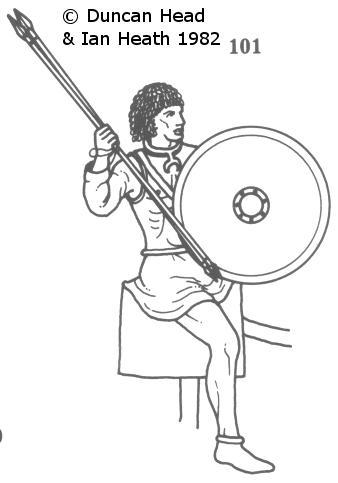
LIBYAN CAVALRYMAN
An extract from Armies of the Macedonian and Punic Warsby Duncan Head, illustrated by Ian Heath
101. LIBYAN CAVALRYMAN

Based on a terracotta figurine of a north African cavalryman. His hair is arranged in tiers of ringlets like the Numidian style (see figure 105) but he differs in several respects from Numidian cavalry. He is seated on a saddlecloth; he certainly wears shoes, and a ridge at his right wrist indicates long sleeves. Visible muscle detail on his chest and a sharp out-turned ridge at the waist suggest he is wearing a Hellenistic muscled plate cuirass. In addition his shield has a rounded boss and raised rim, unlike the Numidian style. He wears a crescent pendant around his neck, recalling the Libyan ornament of figure 104. I suggest therefore that he is a Libyan or Libyphoenician heavy cavalryman in Carthaginian service.
Like 99, he rides an unarmoured horse. Recently Peter Connolly, followed by other writers, has illustrated Carthaginian cavalry with lamellar horse armour of the type worn by figure 167, depicted on the Pergamene reliefs. It cannot be stressed too strongly that there is no evidence for this. No horse armour is shown in the sources for this figure and 99, and it is also absent from the literary evidence. The suggestion that Carthaginian troops used some Hellenistic equipment and will therefore have used Hellenistic horse armour is unfounded, since the horse armour was not in general use among the Hellenistic armies but is unattested outside Asia. In the very unlikely case of any Carthaginian cavalry using horse armour despite the lack of any evidence for it, the Graeco-Oscan style of figure 175 is far more likely than the Asiatic style, as the Carthaginians may have encountered it used by Campanian cavalry.